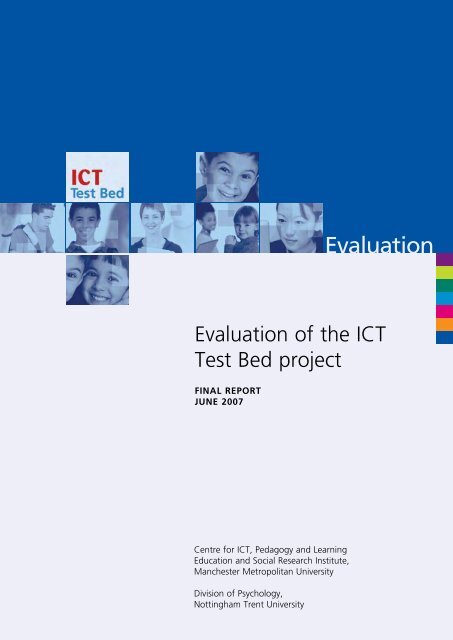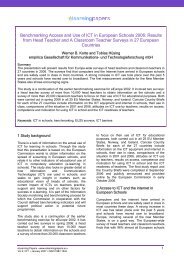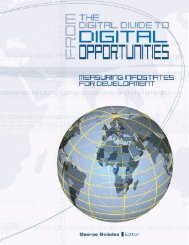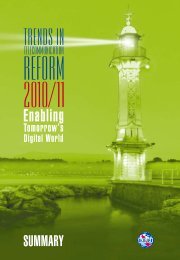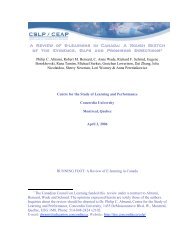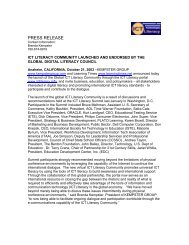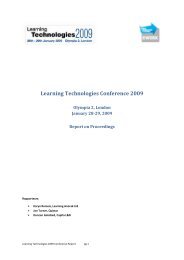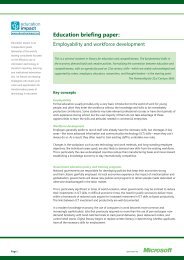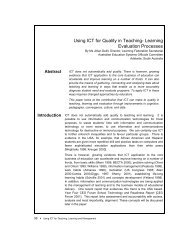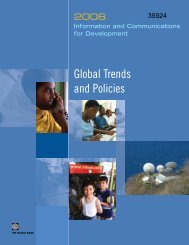Evaluation of the ICT Test Bed Project. report pdf - ICT Digital Literacy
Evaluation of the ICT Test Bed Project. report pdf - ICT Digital Literacy
Evaluation of the ICT Test Bed Project. report pdf - ICT Digital Literacy
You also want an ePaper? Increase the reach of your titles
YUMPU automatically turns print PDFs into web optimized ePapers that Google loves.
<strong>Evaluation</strong><br />
<strong>Evaluation</strong> <strong>of</strong> <strong>the</strong> <strong>ICT</strong><br />
<strong>Test</strong> <strong>Bed</strong> project<br />
Final RepoRt<br />
JUne 2007<br />
Centre for <strong>ICT</strong>, Pedagogy and Learning<br />
Education and Social Research Institute,<br />
Manchester Metropolitan University<br />
Division <strong>of</strong> Psychology,<br />
Nottingham Trent University
Bridget Somekh<br />
Jean Underwood<br />
Andy Convery<br />
Gayle Dillon,<br />
Janis Jarvis<br />
Cathy Lewin<br />
Diane Mavers<br />
Diane Saxon<br />
Sue Sing<br />
Stephen Steadman<br />
Peter Twining<br />
Derek Woodrow<br />
Centre for <strong>ICT</strong>, Pedagogy and Learning<br />
Education and Social Research Institute,<br />
Manchester Metropolitan University<br />
Division <strong>of</strong> Psychology,<br />
Nottingham Trent University
Introduction<br />
1. Introduction<br />
purposes <strong>of</strong> <strong>the</strong> <strong>report</strong><br />
This is <strong>the</strong> final <strong>report</strong> <strong>of</strong> <strong>the</strong> <strong>Evaluation</strong> <strong>of</strong> <strong>the</strong> <strong>ICT</strong> <strong>Test</strong> <strong>Bed</strong> project. It provides key evidence for policy-makers on<br />
<strong>the</strong> impact <strong>of</strong> providing very high levels <strong>of</strong> <strong>ICT</strong> to schools and FE colleges on: teaching and learning; leadership<br />
and management; workforce development; cross-cluster relationships; and home and community links.<br />
By its very nature, a <strong>Test</strong> <strong>Bed</strong> project is ambitious and exploratory. It asks <strong>the</strong> question: “How much can<br />
be achieved by this intervention?” The schools’ and colleges’ action plans focused on specific activities and<br />
tentative targets, but <strong>the</strong> outcomes <strong>of</strong> <strong>the</strong> project were necessarily unpredictable. Its aim was to see to what<br />
extent high levels <strong>of</strong> <strong>ICT</strong> resources could enable schools and colleges to change <strong>the</strong> life chances <strong>of</strong> children and<br />
young people in areas <strong>of</strong> relative socio-economic disadvantage.<br />
<strong>the</strong> ict test <strong>Bed</strong> project<br />
The <strong>ICT</strong> <strong>Test</strong> <strong>Bed</strong> project (2002-06) was initiated by <strong>the</strong> Department for Education and Skills (DfES) to explore<br />
how <strong>ICT</strong> can be used to support <strong>the</strong> Government’s wider agenda for education reform. The project took a<br />
holistic approach to <strong>ICT</strong> implementation in three <strong>ICT</strong> <strong>Test</strong> <strong>Bed</strong> areas <strong>of</strong> relative socio-economic deprivation. A<br />
total <strong>of</strong> £34 million was invested over four years, which gave <strong>the</strong> 28 <strong>ICT</strong> <strong>Test</strong> <strong>Bed</strong> schools and three FE colleges<br />
access to very high levels <strong>of</strong> <strong>ICT</strong> hardware and appropriate s<strong>of</strong>tware. The funding also provided for investment<br />
in staffing release and training support to make <strong>the</strong> most effective use <strong>of</strong> this investment. <strong>ICT</strong> <strong>Test</strong> <strong>Bed</strong> work<br />
focused on using <strong>ICT</strong> to:<br />
• raise standards and performance, especially in <strong>the</strong> areas <strong>of</strong> school and college improvement,<br />
student attainment, and raising <strong>the</strong> quality <strong>of</strong> teaching and learning<br />
• enable more effective leadership and management in schools and colleges<br />
• help teachers to concentrate <strong>the</strong>ir time on <strong>the</strong>ir core task <strong>of</strong> teaching<br />
• enable more effective collaboration between schools and <strong>the</strong>ir local colleges<br />
• provide wider learning opportunities to students, <strong>the</strong>ir families and <strong>the</strong> wider community in<br />
a home environment.<br />
All three <strong>ICT</strong> <strong>Test</strong> <strong>Bed</strong> local authorities have high concentrations <strong>of</strong> deprivation compared to <strong>the</strong> national<br />
average, though manifest in different ways (see Technical Report 25: Cluster Contextual Data).<br />
The three school clusters had slightly different compositions. The Greater London cluster comprised three<br />
secondary schools, each with one <strong>of</strong> <strong>the</strong>ir junior and infant feeder schools. The inner-city cluster in <strong>the</strong> Midlands<br />
comprised a secondary school with seven <strong>of</strong> its feeder primary schools. The rural cluster in <strong>the</strong> North <strong>of</strong> England<br />
comprised a secondary school with nine <strong>of</strong> its feeder primary schools.<br />
The management structures for <strong>the</strong> clusters were set up by <strong>the</strong> local authorities. The style and structures<br />
<strong>of</strong> management set up in <strong>the</strong> three clusters were very different, in each case suiting <strong>the</strong> local authority’s<br />
established patterns <strong>of</strong> relationships with its schools.
Introduction<br />
<br />
It was important that <strong>the</strong> project was mounted quickly to provide ample time to recognise <strong>the</strong> consequences<br />
in teaching and learning, so procurement <strong>of</strong> equipment was rapid. All <strong>the</strong> schools invested in presentational<br />
equipment from <strong>the</strong> start and wireless networks were installed or upgraded. One critical decision was to employ<br />
technicians to support <strong>the</strong> infrastructure and both <strong>the</strong> local authorities and schools appointed a co-ordinator<br />
with significant release time to support colleagues.<br />
three kinds <strong>of</strong> evidence<br />
The <strong>report</strong> is based on three strands <strong>of</strong> evaluation:<br />
Quantitative data:<br />
• Benchmarking <strong>of</strong> changes in performance on national tests against matched comparator schools<br />
and national averages.<br />
• Modelling <strong>of</strong> e-maturity to track institutional change over four years.<br />
• Annual surveys <strong>of</strong> teacher, pupil and parent attitudes and working practices.<br />
Qualitative data:<br />
Site visits including classroom observations, interviews with local authority managers, headteachers, teachers,<br />
administrative staff, technicians and students, and document analysis.<br />
action research data:<br />
During <strong>the</strong> project, more than 90 teachers and para-pr<strong>of</strong>essionals from <strong>the</strong> <strong>ICT</strong> <strong>Test</strong> <strong>Bed</strong> project institutions<br />
completed 116 action research studies <strong>of</strong> <strong>the</strong>ir innovative work with <strong>ICT</strong>.<br />
The final summative evaluation <strong>report</strong>s <strong>of</strong> all three strands, toge<strong>the</strong>r with a number <strong>of</strong> more detailed evaluation<br />
<strong>report</strong>s from <strong>the</strong> four years <strong>of</strong> <strong>the</strong> project listed in Appendix A, are available on <strong>the</strong> <strong>ICT</strong> <strong>Test</strong> <strong>Bed</strong> <strong>Evaluation</strong><br />
website [www.evaluation.icttestbed.org.uk].
Key findings<br />
2. Key findings<br />
learning and teaching<br />
As technology was embedded, schools’ national test outcomes improved beyond expectations.<br />
The impact <strong>of</strong> <strong>ICT</strong> on attainment levels was greater for primary schools than for secondary schools.<br />
Effective use <strong>of</strong> presentation technologies led to greater interaction between teachers and learners.<br />
Effective use <strong>of</strong> <strong>ICT</strong> personalised learning by enabling greater learner choice within <strong>the</strong> curriculum, improved<br />
assessment for learning and more learner-directed teaching.<br />
Technology facilitated more effective assessment for learning by making it easier for learners to be more involved<br />
in target-setting and for teachers to give individualised feedback.<br />
The use <strong>of</strong> electronic registration improved attendance levels in some schools by three to four per cent, while<br />
behaviour management systems were perceived to have a positive impact on both behaviour and attendance,<br />
prerequisites for effective learning.<br />
To enable learners to get <strong>the</strong> maximum learning benefit from using <strong>the</strong> internet, internet protocols that<br />
safeguarded learners’ welfare without being overly prohibitive were required.<br />
Some changes to teaching and learning strategies were inhibited by tensions between <strong>the</strong> priorities <strong>of</strong> different<br />
government policies and agencies with regard to <strong>ICT</strong>.<br />
leadership and management<br />
Institutions that were more e-mature improved <strong>the</strong>ir performance levels significantly more quickly than those<br />
which were not. However, <strong>the</strong>re was a dip in performance until <strong>the</strong> <strong>ICT</strong> became embedded and staff developed<br />
<strong>the</strong> requisite skills.<br />
Managing <strong>the</strong> implementation <strong>of</strong> large amounts <strong>of</strong> <strong>ICT</strong> required a strong vision, an extended planning phase,<br />
staged investment and support throughout.<br />
Schools needed to build sustainability – <strong>of</strong> both resources and pedagogic change – into <strong>the</strong>ir change<br />
management strategies from <strong>the</strong> start.<br />
Ready access to databases, which enable better analysis <strong>of</strong> data, made assessment and planning more<br />
systematic. However, <strong>the</strong>re was a need to ensure that <strong>the</strong> amount <strong>of</strong> analysis required was not overburdensome.<br />
Management information systems (MIS) enabled leaders to better identify <strong>the</strong> particular needs <strong>of</strong> <strong>the</strong>ir school<br />
community through improved data analysis.
Key findings<br />
<br />
Workforce development<br />
The involvement <strong>of</strong> <strong>ICT</strong> changed <strong>the</strong> working practices <strong>of</strong> teachers and extended <strong>the</strong> roles <strong>of</strong> administrative<br />
staff and technicians.<br />
Well co-ordinated and sustained pr<strong>of</strong>essional development opportunities were important in developing <strong>ICT</strong> skills<br />
and confidence <strong>of</strong> all staff and embedding <strong>the</strong> use <strong>of</strong> <strong>ICT</strong>. Informal, on-<strong>the</strong>-job training was very effective when<br />
supported by in-school champions.<br />
Where new technologies were introduced into all <strong>of</strong> a school’s classrooms at <strong>the</strong> same time, a culture <strong>of</strong><br />
sharing and mutual support developed as <strong>the</strong> whole staff faced <strong>the</strong> task <strong>of</strong> embedding <strong>the</strong> technology into<br />
<strong>the</strong>ir pedagogy. Collective need led to collective solutions being found and shared.<br />
Access to reliable technology and daily use led to rapid improvements in teachers’ skills and improved<br />
management <strong>of</strong> workloads.<br />
Shared server areas and virtual learning environments made it easier for teachers to find, store, share, create and<br />
reuse resources and lesson plans. This ensured long-term value from <strong>the</strong> initial high investment by <strong>the</strong> workforce.<br />
cross-institution links<br />
Effective cross-institution collaboration required a common purpose and leadership from <strong>the</strong> top. Plenty <strong>of</strong> time<br />
for staff to meet and establish trust needed to be built into <strong>the</strong> process, with roles and responsibilities clearly<br />
identified. This was especially important in <strong>the</strong> cross-sectoral collaboration.<br />
home and community links<br />
The majority <strong>of</strong> students in <strong>ICT</strong> <strong>Test</strong> <strong>Bed</strong> schools, as in o<strong>the</strong>r schools, now have access to computers at home.<br />
Loaning <strong>ICT</strong> equipment to learners helps to bridge <strong>the</strong> digital divide.<br />
<strong>ICT</strong> made it much easier to share assessment information with parents via school websites or learning platforms.<br />
Schools slowly increased <strong>the</strong>ir use <strong>of</strong> email – and, in some cases, text messages – to communicate with parents,<br />
enabling <strong>the</strong>m to respond to parental enquiries more rapidly. However, establishing a two-way dialogue with<br />
parents was more challenging.<br />
Increasing home access to <strong>ICT</strong> and <strong>the</strong> internet was operationally difficult for schools. It was very timeconsuming<br />
and required careful planning.
22<br />
Workforce development<br />
5. Workforce development<br />
<strong>the</strong> involvement <strong>of</strong> ict changes <strong>the</strong> working practices <strong>of</strong> teachers and extends <strong>the</strong><br />
roles <strong>of</strong> administrative staff and technicians.<br />
The annual surveys have shown year-on-year growth in <strong>ICT</strong> competence and confidence for staff, students and<br />
parents at all levels, demonstrating that those sampled are now very much part <strong>of</strong> <strong>the</strong> e-society that pervades<br />
life today. The growing e-maturity <strong>of</strong> <strong>the</strong> workforce manifested itself not only in <strong>the</strong> increasing level <strong>of</strong> skills <strong>of</strong><br />
<strong>the</strong> more advanced staff, but also in <strong>the</strong> widening <strong>of</strong> participation in developing and using <strong>ICT</strong> resources across<br />
<strong>the</strong> whole staff within <strong>the</strong> project institutions.<br />
<strong>ICT</strong> enables teachers to use new, more efficient methods <strong>of</strong> locating and creating resources. They can search,<br />
create and adapt materials using a much wider range <strong>of</strong> sources than previously to form new learning activities.<br />
The initial making or researching <strong>of</strong> classroom resources is hard work for teachers, but <strong>the</strong> ease <strong>of</strong> storage and<br />
retrieval is making a major impact on future lesson preparation.<br />
Resources which supported teachers in creating <strong>the</strong>ir own materials (providing clip art and video clips as well<br />
as construction tools) were deemed valuable by primary teachers, whereas secondary teachers used generic<br />
word-processing, presentational and spreadsheet programs.<br />
<strong>ICT</strong> creates a new and increased culture <strong>of</strong> sharing <strong>of</strong> materials and resources between teachers, through<br />
shared server areas or online learning environments at all schools levels. In primary schools, sharing <strong>of</strong> resources<br />
happens within year groups and in secondary schools within departments.<br />
The use <strong>of</strong> presentation technologies (data projectors and ancillary equipment such as interactive whiteboards<br />
and visualisers) led to rapid development <strong>of</strong> teachers’ <strong>ICT</strong> skills, and a more interactive style <strong>of</strong> teaching. The<br />
value which arises from preparation <strong>of</strong> slides and lesson images fits closely with what teachers like to do and<br />
encourages <strong>the</strong>m to plan <strong>the</strong>ir lessons in greater detail. In doing this, <strong>the</strong>ir computer skills were implicitly<br />
increased and <strong>ICT</strong> became an embedded natural part <strong>of</strong> <strong>the</strong>ir classroom.<br />
When <strong>the</strong> planning and presentation is accomplished in advance, <strong>the</strong> teacher can concentrate in <strong>the</strong> lesson<br />
on <strong>the</strong> pupils and <strong>the</strong>ir responses, creating an easier forum for discussion and interaction with <strong>the</strong> pupils. The<br />
ease <strong>of</strong> adapting, adding and saving interactive whiteboard pages leads to more teacher-student interaction in<br />
developing conceptual statements and greater coherence and consistency in <strong>the</strong>se descriptors over time.<br />
The training <strong>of</strong> teaching assistants gave <strong>the</strong>m an improved status and confidence in <strong>the</strong> classroom and this was<br />
invaluable in developing <strong>ICT</strong> use and resources. Teaching assistants also helped ensure continuity when supply<br />
teachers were needed since <strong>the</strong>y were familiar with <strong>the</strong> systems and resources to be used in class. In some<br />
project schools, teaching assistants developed specific skills such as animation and video editing to support<br />
teachers and students.<br />
Teaching assistants support individual pupils and groups in working on computers in <strong>the</strong>ir classrooms, and <strong>the</strong>y<br />
support teachers, especially at <strong>the</strong> foundation stage, in conducting assessment tasks.<br />
Technicians had enhanced roles and were vital for <strong>the</strong> school or college to maintain its high level <strong>of</strong> use <strong>of</strong> <strong>ICT</strong>.<br />
As <strong>the</strong> <strong>ICT</strong> investment developed, so technicians had to develop fur<strong>the</strong>r skills and knowledge. Their need for<br />
training was not always recognised and like <strong>the</strong> administrative staff this needs co-ordination and support by <strong>the</strong><br />
local authorities.
Workforce development<br />
23<br />
Improved MIS systems and administrative processes made administrative roles more demanding but produced<br />
significant gains in <strong>the</strong> availability, use and accuracy <strong>of</strong> data at all levels <strong>of</strong> <strong>the</strong> organisation. They <strong>of</strong>ten led<br />
to closer co-operation between teaching and administrative staff in securing and maintaining <strong>the</strong> data. These<br />
staff needed training, not just when new systems were implemented but to enrich <strong>the</strong>ir existing skills. This was<br />
found to be best co-ordinated by <strong>the</strong> local authority so as to provide for staff who are <strong>of</strong>ten isolated in <strong>the</strong>ir<br />
own schools.<br />
In primary schools, MIS have revolutionised <strong>the</strong> role and skills required for school secretaries, providing greatly<br />
enhanced status and involvement in <strong>the</strong> educational process.<br />
From fairly low levels <strong>of</strong> <strong>ICT</strong> resource at home in <strong>the</strong> first year <strong>of</strong> <strong>the</strong> project, by 2006 <strong>the</strong> majority <strong>of</strong> teaching<br />
and support staff could access <strong>ICT</strong> at home and at school.<br />
Well co-ordinated and sustained pr<strong>of</strong>essional development opportunities were<br />
important in developing ict skills and confidence <strong>of</strong> all staff and embedding<br />
<strong>the</strong> use <strong>of</strong> ict. informal, on-<strong>the</strong>-job training is very effective when supported by<br />
in-school champions.<br />
Training needed to be co-ordinated with <strong>the</strong> introduction <strong>of</strong> <strong>the</strong> equipment so that staff were able to practise<br />
<strong>the</strong>ir newly learned skills. It needed to be timetabled carefully so that participants do not feel overwhelmed.<br />
Poor initial training can lead to staff not taking up <strong>the</strong> new resource and recovery <strong>of</strong> <strong>the</strong> initiative is difficult and<br />
time-consuming. Training also needs to continue after <strong>the</strong> initial phase in order to ensure that new learning can<br />
take place and so that ‘bad habits’ can be addressed.<br />
The local authorities and Becta <strong>of</strong>fered training and carried out an analysis <strong>of</strong> staff skills which was used to<br />
develop a programme <strong>of</strong> continuing pr<strong>of</strong>essional development (CPD) matched to skills requirements. The<br />
change management tools, developed by <strong>the</strong> National Remodelling Team in 2003 to support workforce reform<br />
agenda, were very helpful [http://www.tda.gov.uk/remodelling/managingchange/tools.aspx]. Some<br />
providers <strong>of</strong> resources and equipment have provided excellent support and managers should explore with<br />
suppliers <strong>the</strong> support <strong>of</strong>fered before committing to a new resource. Central systems – such as MIS and learning<br />
platforms, in particular – needed good training packages.<br />
For primary schools, a progressive programme <strong>of</strong> training for representative teachers from <strong>the</strong> schools was<br />
cascaded back into <strong>the</strong> schools very effectively. Most schools had members <strong>of</strong> staff who had become<br />
accomplished with certain pieces <strong>of</strong> equipment, and <strong>the</strong>n supported and sustained activity undertaken with<br />
that equipment by <strong>the</strong>ir colleagues. The key was <strong>the</strong> corporate and co-ordinated approach taken between<br />
and within <strong>the</strong> schools.<br />
One school followed a planned four-week cycle:<br />
Week one involved a model lesson and demonstrating a piece <strong>of</strong> equipment.<br />
Week two involved team teaching.<br />
Week three was spent using <strong>the</strong> equipment and experimenting.<br />
Week four was an assessment <strong>of</strong> how and when to use <strong>the</strong> equipment.
24<br />
Workforce development<br />
Primary <strong>ICT</strong> co-ordinators also played a major role in raising skills levels within schools using <strong>the</strong>ir increased nonteaching<br />
time to work with colleagues in order to develop <strong>the</strong>ir use <strong>of</strong> <strong>the</strong> technology. External trainers were used<br />
for specific events and <strong>the</strong> FE colleges in <strong>the</strong> clusters <strong>of</strong>fered a range <strong>of</strong> training opportunities to school staff.<br />
Secondary schools also brought in external trainers for specific subjects. Change management training<br />
organised by <strong>the</strong> local authority was valuable in helping to implement <strong>the</strong> project. As <strong>the</strong> project progressed,<br />
secondary schools drew more on <strong>the</strong>ir own resources for staff CPD, using <strong>the</strong> specialist IT and o<strong>the</strong>r teachers,<br />
technicians and content developers to deliver specific training. Advanced skills teachers (ASTs) played an<br />
important role in designing and delivering this training. ASTs who have been trained in coaching skills have<br />
<strong>the</strong>n coached colleagues within <strong>the</strong> department and sometimes within <strong>the</strong> wider school.<br />
The most effective training was <strong>of</strong>ten informal, involving teamwork and mutual support. Training became<br />
more effective when staff could see what colleagues were doing, take part in more informal team learning<br />
and practise with <strong>the</strong> equipment on <strong>the</strong>ir own. The development <strong>of</strong> ‘champions’ with expertise in particular<br />
equipment was valuable – both in primary schools and within secondary departments – in providing support<br />
at <strong>the</strong> point <strong>of</strong> need. This was particularly effective when <strong>the</strong> role <strong>of</strong> ‘champion’ was spread among colleagues<br />
and not focused on a single school/department expert.<br />
I’ve learned more from *** or from *** about little tips <strong>of</strong> shortcutting. I think it’s time we started looking at<br />
what we’ve got in <strong>the</strong> school and using it. (Secondary schoolteacher)<br />
We hold weekly training sessions… <strong>the</strong> staff team get toge<strong>the</strong>r in small clusters and train each o<strong>the</strong>r, show each<br />
o<strong>the</strong>r techniques and ideas. They are not told ‘do it’; <strong>the</strong>y do it as <strong>the</strong>y’re pr<strong>of</strong>essionals. (Secondary head <strong>of</strong> <strong>ICT</strong>)<br />
Action research supported pr<strong>of</strong>essional development and pedagogical change. It was valued highly by <strong>the</strong><br />
staff in primary schools and in FE colleges who took part. The participation by secondary teachers was very<br />
low, reflecting <strong>the</strong> general lack <strong>of</strong> priority for generic CPD by secondary teachers, for whom subject-focused<br />
development is central.<br />
introducing new technologies into all classrooms at <strong>the</strong> same time created a<br />
culture <strong>of</strong> sharing and mutual support, as <strong>the</strong> staff as a whole faced <strong>the</strong> challenge<br />
<strong>of</strong> embedding <strong>the</strong> technology into <strong>the</strong>ir pedagogy.<br />
Installation <strong>of</strong> <strong>ICT</strong> equipment in all classrooms at <strong>the</strong> same time proved to be one <strong>of</strong> <strong>the</strong> best ways <strong>of</strong> getting<br />
staff to form a mutual support group and learn toge<strong>the</strong>r, as collective need led to collective solutions being<br />
found and shared. In <strong>the</strong> long term, this had a pr<strong>of</strong>ound positive effect on embedding pedagogic change. This<br />
was true in all <strong>the</strong> <strong>ICT</strong> <strong>Test</strong> <strong>Bed</strong> primary schools, in some secondary school departments and in <strong>the</strong> selected<br />
curriculum areas in <strong>the</strong> three colleges. The key lesson here is that embedding change in pedagogic practice is<br />
more likely to occur if <strong>the</strong>re is a combined focus by all staff on using new <strong>ICT</strong> equipment and s<strong>of</strong>tware, ra<strong>the</strong>r<br />
than a gradual introduction over time.<br />
access to reliable technology and its use on a daily basis led to rapid<br />
improvements in teachers’ skills and improved management <strong>of</strong> workloads.<br />
Daily use <strong>of</strong> presentation technologies led to rapid gains in teachers’ <strong>ICT</strong> skills. Interactive whiteboards and<br />
visualisers with data projectors were easily <strong>the</strong> innovations most readily welcomed by <strong>the</strong> teachers and <strong>the</strong> one<br />
to which <strong>the</strong>y were most committed.<br />
Personal access to PCs or laptops had a major impact on teachers’ roles and that <strong>of</strong> <strong>the</strong> support staff, giving<br />
flexibility and choice with regard to <strong>the</strong> location <strong>of</strong> work. One consequence <strong>of</strong> <strong>the</strong> increased skills developed by<br />
teachers and support staff was that <strong>the</strong>y felt more confident in dealing with technical hitches and failures.
Workforce development<br />
25<br />
Shared server areas and virtual learning environments made it easier for teachers<br />
to find, store, share, create and reuse resources and lesson plans. this ensured<br />
long-term value from <strong>the</strong> initial high investment by <strong>the</strong> workforce.<br />
Teachers have always shared ideas and activities, but <strong>the</strong> ease <strong>of</strong> access and immediate availability <strong>of</strong> o<strong>the</strong>r<br />
teachers’ resources made a significant difference in <strong>the</strong> corporate planning and development <strong>of</strong> teaching<br />
resources. It also brought with it new tasks for organising and maintaining resources.<br />
There was a need to do assembly on Monday and two minutes later whack toge<strong>the</strong>r a quick presentation.<br />
That was with <strong>the</strong> lower school. Walking in on Wednesday, I saw my presentation up on <strong>the</strong> screen being used<br />
by <strong>the</strong> teachers in <strong>the</strong> upper school, adapted to meet <strong>the</strong>ir needs. I thought that this is fantastic.<br />
(Primary deputy headteacher)<br />
<strong>ICT</strong> created a new and increased culture <strong>of</strong> sharing <strong>of</strong> materials and resources through shared server areas or<br />
online learning environments at all schools levels. The establishment <strong>of</strong> shared network access was a major<br />
instigator for such staff activity in sharing resources and ideas. The common availability <strong>of</strong> <strong>the</strong>se resources and<br />
planning made it easier to incorporate and support supply teachers and to induct new teachers into <strong>the</strong> school<br />
ethos. It also provided greater consistency for <strong>the</strong> learners.<br />
Some schools joined with o<strong>the</strong>rs in <strong>the</strong>ir cluster to create resources and o<strong>the</strong>rs were supported by experienced<br />
‘content teams’ from <strong>the</strong> local FE college or <strong>the</strong> partner secondary school.<br />
Content creation teams and resources developed by groups <strong>of</strong> teachers were found to be helpful but <strong>the</strong>y<br />
were generally used as a stimulus for ideas ra<strong>the</strong>r than as presented. Animations and small flash programs<br />
created by <strong>the</strong> content creation teams were particularly useful, but <strong>the</strong>y should be developed closely with<br />
teachers so as to provide a source <strong>of</strong> expertise enabling teaching staff to become more skilled. ‘Ownership’ <strong>of</strong><br />
resources – that is, teachers having a close understanding <strong>of</strong>, and sympathy with, what <strong>the</strong> program contains<br />
and is trying to achieve – is a critical issue for teachers and hence content development needs to be tailored<br />
for individual and local needs.<br />
Establishment <strong>of</strong> virtual learning environments did not get fully underway until <strong>the</strong> third year <strong>of</strong> <strong>the</strong> project,<br />
when <strong>the</strong>y had become fit for purpose. This was frequently a learning experience for schools and developers<br />
alike. Where virtual learning environments have been initiated, <strong>the</strong>re is evidence <strong>of</strong> secondary school students<br />
having growing access to <strong>the</strong>m, though at <strong>the</strong> moment only a small number <strong>of</strong> parents access <strong>the</strong>se resources<br />
with any regularity.<br />
The development <strong>of</strong> <strong>the</strong> learning platform in one <strong>of</strong> <strong>the</strong> <strong>ICT</strong> <strong>Test</strong> <strong>Bed</strong> clusters has been trailblazing. It was<br />
not simply a matter <strong>of</strong> identifying technical solutions but also a matter <strong>of</strong> major cultural change, and it is not<br />
surprising that <strong>the</strong> learning platform is still at a relatively early stage <strong>of</strong> development at <strong>the</strong> end <strong>of</strong> <strong>the</strong> <strong>ICT</strong><br />
<strong>Test</strong> <strong>Bed</strong> funded period. The use <strong>of</strong> <strong>the</strong> learning platform was due to <strong>the</strong> hard work and commitment <strong>of</strong> staff<br />
and senior managers, and has been achieved through <strong>the</strong> careful choice <strong>of</strong> initial innovation topics presenting<br />
‘quick wins’ for teachers and o<strong>the</strong>r users. Email and communication gains were an early development, (see <strong>the</strong><br />
focused study: A Case Study <strong>of</strong> <strong>the</strong> Learning Platform(s) in One Cluster).
Millburn Hill Road<br />
Science Park<br />
Coventry<br />
CV4 7JJ<br />
Tel: 024 7641 6994<br />
Fax: 024 7641 1418<br />
Email: research@becta.org.uk.<br />
URL: http://www.becta.org.uk


